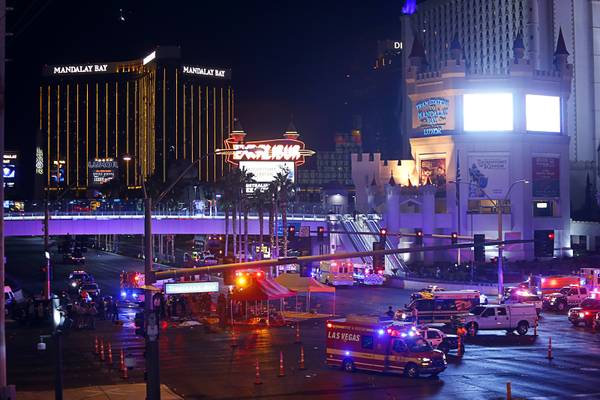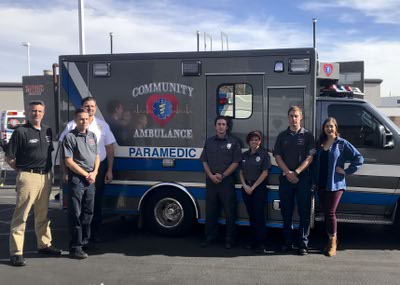Two months after they responded to the deadliest mass shooting in modern U.S. history, members of the on-site medical crew are still processing what they witnessed and have been relying on each other to heal.
The Community Ambulance staff, contracted for the Route 91 Harvest Festival, have been acting as a family ever since the Oct. 1 massacre that left 58 dead and more than 500 injured. Representatives of Community Ambulance recently met with the Las Vegas Sun to share their stories of the horrific night.
After two fairly quiet days tending to concertgoers at the three-day music festival on the Las Vegas Strip, the pace picked up on the final day. Alcohol-related incidents ramped up for the Community Ambulance staff ahead of the festival’s headliner, Jason Aldean, taking the stage.
Nothing was out of the ordinary from what the crew members had seen the previous year when they staffed the festival. A couple of songs into Aldean’s set, Community Ambulance got a call about a couple needing assistance at Gate 2A on Las Vegas Boulevard.
"It was an intoxicated couple — the wife had a little too much to drink, and they just wanted to go home," said Glen Simpson, special events manager for Community Ambulance. “Metro came over and were able to get this couple in a cab.”
As Simpson and the officers walked back from helping the couple, they heard what turned out to be the first three shots.
“It made a unique crackling sound, and people didn’t think anything of it,” Simpson said. “To me, it sounded like power lines were hitting one another.”
A few seconds later, Simpson heard a burst of shots from across Las Vegas Boulevard. What he initially thought was nothing to worry about ended up being his worst fear, he said.
“The first volley of shots were fired, and at that point the Metro officers pulled their weapons,” he said. “We knew it was coming from the direction of Mandalay Bay — we didn’t know it was coming from above.”
Simpson took cover behind a 3-foot tall cinder-block wall for about 10-15 seconds before he decided to bolt across the festival grounds.
As Aldean left the stage and the crowd began to react, Simpson made his way through the sea of fleeing people, diving for cover behind one of the bars in the festival. He radioed dispatch and asked for ambulances. He and the rest of Community Ambulance crew then jumped into action, providing initial medical care.
A gunman perched in a room on Mandalay Bay’s 32nd floor continued to fire at the crowd of 22,000.
Michael Gloeckner, special events lead for Community Ambulance, said he saw throngs of people running every which way, tearing down fences, pushing each other. “You could see the fear in their eyes,” Gloeckner recalled.
As Gloeckner reached the medical tent with other Community Ambulance team members already there, the rush began.
“A man walked up to me and handed me a lady, saying she’d been shot,” Gloeckner said.
“A blink of an eye later, and the (medical) tent was full,”
With gurneys and beds in the tent already being used, the crew soon turned to chairs and eventually placed patients on the ground as the wounded kept coming. The crew used all the tourniquets they had to stop bleeding. After that, they used belts, cut-up sheets and even stethoscopes.
“Once we ran out of those, we started doing more interventions — plugging holes in chests, listening for lung sounds,” Gloeckner said. “(We were) trying to stop as much bleeding as we could.”
Concertgoers with medical expertise entered the area to help. The group included doctors, nurses and EMTs from all over the U.S. and countries as far as Australia.
After triaging victims in the field, Troy Goldbaum, an advanced emergency medical technician, got word an officer had been shot.
“I got paired up with some officers who grabbed their helmets, vests and semiautomatic rifles and got behind them. We went in and tried to find the officer,” Goldbaum said. “After looking though half of the venue, we were told he (the officer) got out.”
Goldbaum had received training with the Henderson Fire Department that included responding to an active-shooter situation with law enforcement officers. He credited that training with helping him keep it together under pressure.
“I was lucky to have that so fresh in my mind,” he said. “I was in the field and doing the steps my training officer told me.”
After tending to victims for about 10 minutes in the medical tent, the crew began seeking ambulances to transport the most gravely injured people.
Victims were given one of three color-coded priorities: green, those who had wounds but did not have life-threatening injuries; yellow, those who had moderate injuries and needed to get to a hospital soon; and red, those who were in critical condition and needed to be transported right away. Victims initially evaluated in the yellow category sometimes worsened and were moved to the red group, and vice versa.
The first patients were transported to hospitals in private vehicles, cramming as many as they could into cars or truck beds.
When medical supplies began to dwindle in the tent, Gloeckner busted through the back to get to two Community Ambulances parked at the nearby Catholic church to grab additional supplies.
Metro vehicles, other emergency vehicles and personal vehicles transported more victims. Ambulances crammed as many people as possible.
“In the first ambulance that arrived, we easily put eight to nine people inside, four of which were in very critical condition,” Simpson said. One of the first Community Ambulances full of patients was driven by an off-duty member of their team who happened to be attending the music festival.
“He came up and was seeking permission, and I just said, ‘Go,’” Simpson said.
As patients in the tent died, they were moved to make room for more of the wounded who needed care.
Melanie Ondik, clinical manager for Community Ambulance, was in charge of the door, making sure victims taken into the area were still alive.
“They were bringing them into the door, and I would stop them and check for pulses,” Ondik said. “If they didn’t (have a pulse), I would tell them to leave them to the side and not to bring them in.”
Emotions ran high amid the chaos and the rising death toll. A man punched an EMT in the back of the head after the EMT told him that the victim he brought to the tent was dead, Gloeckner said.
The crew worked for hours at the site, still finding and treating patients who fled the scene to surrounding areas at around 3 a.m.
“We found a mother and a daughter who were hiding out at the farthest east entrance of the church’s parking, thinking the shooter could still be out there,” Simpson said. “A lot of people lost their cellphones … (they) couldn’t reach out of help, even if they wanted to.”
Community Ambulance called in a psychologist the day after the attack to be available for a few weeks. But some of the best healing came from each other.
Crew members have come together on multiple occasions, including a family-style barbecue and a photo session.
“Just being together, visiting and talking was some of the most beneficial time,” said Brian Anderson, general manager of Community Ambulance. “More so than any one-on-one time with a psychologist or other mental health professionals.”
The support of his employer has been essential in the healing process, Goldbaum said.
“I remember countless times when everyone who was there … asking us and texting us if you’re all right,” he said. “It wasn’t just one time. It was day after day. They’ve made sure that we’re not alone and that we’ve had support. It’s been unreal.”


